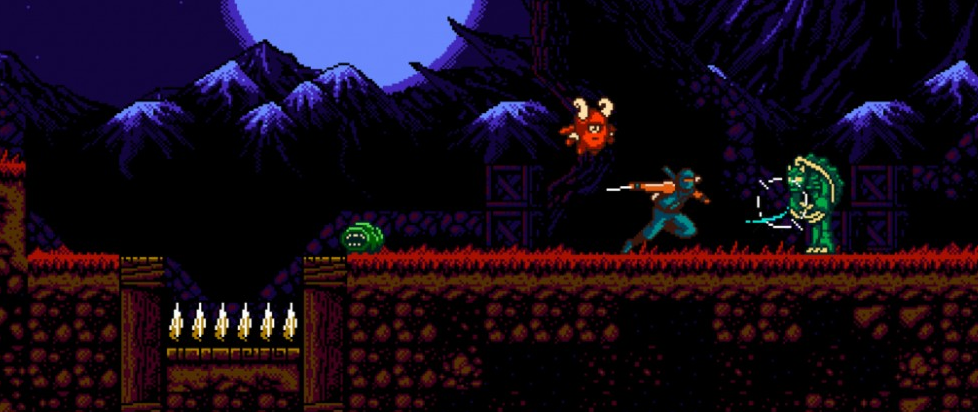
The Message
Level design is one of the cornerstones of good game design, but we’ve become so used to genre conventions that we pretty much know what to expect from levels once it becomes clear what genre a game is. 2D side-scrolling games are among the most staid of these, telegraphing its texture from being played for just a few minutes thanks to how extensive of a history the genre holds within the games industry. The difficulty ratchets up and some new mechanics are sprinkled in gradually, sure, but it’s very rare for you to be surprised by the level design in general. Somehow, though, The Messenger pulls it off, and it does so simply by recycling the levels you’ve gone through in one half of the game and completely changing the context of how you interact with them in the second, transcending genres and even video game eras in the process.
You start out your journey in The Messenger in a very basic Ninja Gaiden-styled game, complete with how your ninja avatar swings his sword and the lanterns you can break to get items. Though it’s missing the different powerups you could get in Ninja Gaiden, it makes up for it with a couple of novel abilities that are available to you at different points. You start with the ability to Cloudstep, which gives you an extra jump in the air if you’ve attacked something – unlike Ninja Gaiden, those lanterns don’t go away when broken, providing you with a stepping stone – and later you’re given a horizontal grappling hook which you can use in conjunction with the Cloudstep for some tricky traversal puzzles later on.
The Messenger proves competent at providing a slowly escalating challenge, but nothing about the level design itself ever truly surprises when you’re first playing through the stages. A lot of this isn’t necessarily the game’s fault, but more that it has the storied history of platformers to lean on. At this point in game history, we all have an image of what a platformer is, as well as what all the different platforming subgenres are. Here, The Messenger takes the form of a Point A to Point B platformer, complete with distinct stages and end bosses. The levels are divided up into rooms that feature multiple distinct challenges that are a mix between traversal and combat, occasionally blending the two. The Cloudstep becomes more and more prominently required to progress, but aside from that, nothing about the game feels especially good or out of the ordinary.
That is, until you get halfway in and it becomes an entirely different genre. After you’ve gone through most of the levels, you’re then tasked with combing them again for different items that will unlock other areas and even completely new stages, resembling something like a metroidvania, only in this one, you’re already intimately familiar with the world you’re exploring. In truth, it uses a similar structure to Capcom’s Demon’s Crest, which was also made up of linear levels that branched out to new, hidden ones if you explored with the right abilities. Demon’s Crest was like that from the word go, though. Here, The Messenger’s opening hours amount to a bait and switch, blossoming into a new game in the process even as the levels remain largely unchanged.
This also means a lot of backtracking, which would be a big problem if you had to spend the back half of the game in those same levels, but The Messenger employs a clever trick: time travel. After the halfway point is hit, rifts start opening up in the levels that you can go through to travel between the present and the future. When you travel to the future, suddenly the graphics and music become a bit more elaborate, transforming everything to have more of a 16-bit feel. The levels are also remixed with different obstacles and enemies, and progressing to new areas will often mean switching between the two. It’s like the time travel mechanic in Sonic CD if it was actually required to complete the game. Remixing the levels and adding in a time-shifting mechanic breathes new life into what you’ve already completed.
What this says about level design in general is handled with the subtlety of a sledgehammer and twice as cynically. The Messenger is literally two subgenres of platformers grafted together at the midsection. But the message, so to speak, is no less profound: Level design doesn’t only depend on itself to be great, but rather the context into which you place it can significantly elevate the experience. We think of level design as building rooms and bosses, but it also warps based on how it’s approached, in what order will the player be experiencing things, or even, yes, what you can discover in them once you can do something new. It speaks to the strength and breadth of what videogames can be when you can take a single pillar of design and present it in two radically different ways. It takes a while to see the whole tapestry that it stitches together from two halves, but ultimately The Messenger delivers.




